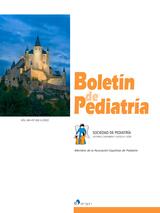Demanda asistencial en un Servicio de Pediatría durante el estado de alarma secundario a la COVID-19
M.J. Gamero García , M. Mosquera Frouf , P. Sánchez Rodríguez , J. López-Ávila , C. Criado-Muriel
Bol. Pediatr. 2022; 62 (260): 103 - 110
Antecedentes y objetivos. La COVID-19 es una enfermedad producida por el virus SARS-CoV-2. En España, entre el mes de marzo y junio de 2020 se declaró el primer Estado de Alarma con el fin de contener la pandemia. Nuestro objetivo es evaluar la demanda asistencial y las enfermedades que acudieron a Urgencias Pediátricas y que fueron ingresadas durante el tiempo que duró el primer Estado de Alarma, comparando con los mismos meses de los años 2018 y 2019. Resultados. Existe una reducción del número de ingresos de 345 a 141, un incremento de la complejidad demostrada por una mayor duración de los ingresos hasta 7,3±12,4 días (6,2±8,6 días en 2018 y 4,8±6,9 en 2019). Las enfermedades infecciosas (principalmente las respiratorias) descendieron, permaneciendo estables los ingresos por neoplasias, patología psiquiátrica, apendicitis y enfermedades circulatorias. En Urgencias Pediátricas, en los años 2018 y 2019 (de 1 marzo a 30 junio) se atendieron 9.075 y 8.525 pacientes, mientras que en el 2020 se atendieron 2.215, aumentando el porcentaje de ingresos procedentes de urgencias del 3,6% y 3,4% al 6% en 2020. Las enfermedades que aumentaron de forma más importante fueron las lesiones traumáticas y las intoxicaciones. Tanto en los ingresos como en urgencias existe un incremento en la edad de los pacientes. Conclusiones. El Estado de Alarma influyó en la presión asistencial y en el tipo de enfermedades atendidas en el Servicio de Pediatría, con una disminución del número de Urgencias y de ingresos, un incremento de la edad y una modificación del tipo de enfermedades atendidas.
Demand for care in a Pediatric Service during the state of alarm secondary to COVID-19
Introduction and objectives. COVID-19 is a disease caused by the SARS-CoV-2 virus. In Spain, between March and June 2020, the first State of Alarm was declared in order to contain the pandemic. Our objective is to evaluate the healthcare demand and the diseases that came to the Pediatric Emergency Department and were admitted during the time that the first State of Alarm lasted, comparing with the same months of the years 2018 and 2019. Results. There is a reduction in the number of admissions from 345 to 141, an increase in complexity demonstrated by a longer duration of admissions to 7.3±12.4 days (6.2±8.6 days in 2018 and 4, 8±6.9 in 2019). Infectious diseases (mainly respiratory) decreased, with admissions for neoplasms, psychiatric pathology, appendicitis and circulatory diseases remaining stable. In Pediatric Emergencies, in the years 2018 and 2019 (from March 1 to June 30), 9,075 and 8,525 patients were attended, while in 2020, 2,215 were attended, increasing the percentage of admissions from the emergency room of 3.6% and 3.4% to 6% in 2020. The diseases that increased most significantly were traumatic injuries and poisonings. Both in admissions and in emergencies there is an increase in the age of the patients. Conclusions. The State of Alarm influenced the care pressure and the type of diseases treated in the Pediatric Service, with a decrease in the number of Emergencies and admissions, an increase in age and a modification of the type of diseases treated.
Artículo completo (PDF) (168 kb.)
- Otros
Buscar en el boletín
Año 2022, Volumen 62, Número 260

Boletín completo en PDF (8748 kb.)